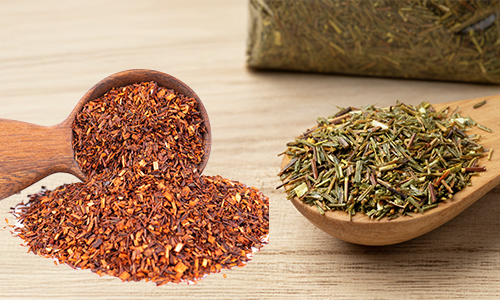Why is Rooibos getting attention?

In today’s trend of “less sugar, lighter burden, functional drinks,” consumers increasingly value the health attributes of beverages. Rooibos is gaining popularity for being caffeine-free, antioxidant-rich, and gentle on the stomach. Originating from South Africa, it is gradually expanding into the international market.
The rooibos plant (Aspalathus linearis) grows in the Western Cape region of South Africa, about 200 km from Cape Town, in dry, poor soil. Its thin, needle-like leaves turn reddish when processed; in Afrikaans, “rooibos” literally means “red bush.”
Red Rooibos vs Green Rooibos

- Red Rooibos (fermented): After harvesting, the leaves undergo natural fermentation. The tea liquor becomes reddish in color. It offers caramel- and honey-like sweetness, with a mellow mouthfeel. Perfect for relaxation and evening drinking.
- Green Rooibos (unfermented): Leaves are kept from oxidizing, preserving higher polyphenol content. The liquor appears pale gold or light green, and the taste is more herbaceous and crisp. More suited for daytime consumption or pairing with fruits.
Tip: Red rooibos is sweeter and smoother; green rooibos is fresher and more herbaceous. They complement each other depending on the drinking context.
7 Key Benefits of Rooibos Tea
- Caffeine-free — Suitable for pregnant women, children, or those sensitive to caffeine; safe even in the evening.
- Unique Antioxidants — Contains rare compounds such as aspalathin and nothofagin, which help neutralize free radicals caused by stress, UV, and metabolism.
- Supports Cardiovascular Health — Polyphenols may help maintain vascular elasticity and reduce oxidative stress.
- Reduces Inflammation — Supplies phytonutrients that may ease chronic inflammation.
- Gentle on the Stomach — With a pH around 5.5–6.5 and very low tannin content, it avoids bitterness and doesn’t significantly hinder iron absorption.
- Good for Daily Maintenance — Long-term drinking may support skin health and cellular balance, offering gentle wellness benefits.
- Versatile in Use — Works as a base tea for fruit teas, tea-cap styles, or even dessert infusions, unlocking creativity in menus.
Note: Antioxidants are not the same as medicines—they act more like a “protective umbrella” for cells.
Matcha, Coffee & Rooibos: Which Suits You Best?
| Beverage | Caffeine Content | Antioxidant Features | Stomach Irritation | Best Occasion |
| Red Rooibos | None | Aspalathin, Nothofagin | Very gentle | Evening, relaxation |
| Green Rooibos | None | Higher native polyphenols | Very gentle | Daytime, refreshing |
| Matcha | Moderate (38–176 mg) | Catechins (EGCG), strong antioxidant | Slight stimulation | Focus, alertness |
| Coffee | High (80–100 mg) | Chlorogenic acid, antioxidant + boost | Most irritating | Quick energy boost |
- Matcha: Rich in EGCG, strong antioxidant effect, moderately stimulating.
- Coffee: Contains chlorogenic acid, but high caffeine and acidity can upset the stomach.
- Rooibos: Gentle, caffeine-free, suitable for evening or all-day drinking.
Summary:
- For calm and rest: choose rooibos.
- For strong antioxidant support: choose matcha.
- For quick energy: choose coffee.
Rooibos in Beverages & Market Potential
- Evening relaxing drink: Red rooibos with caramel, grass jelly, or soothing flavors.
- Daytime refreshing drink: Green rooibos with lemon, grapefruit, or sparkling water.
- Creative fruit blends: Red rooibos with apple or caramel; green rooibos with passion fruit or rose.
For beverage brands and tea shops, rooibos offers three key advantages:
- Stable serving — Tea bags and consistent packaging ensure reliable quality.
- Health alignment — Meets demand for caffeine-free, low-burden beverages.
- Differentiated positioning — Stands apart from coffee and traditional teas, highlighting a unique niche.
Drink the Right Tea, Live More Peacefully
With no caffeine, unique antioxidants, and a gentle nature, South African rooibos is becoming a rising star in the global tea market. Red rooibos is sweet and soothing; green rooibos is fresh and herbaceous. Depending on your mood or time of day, both can fit seamlessly into your lifestyle.
For consumers, it’s a safe everyday tea. For businesses, it’s a strategic choice that captures both health trends and market differentiation.




